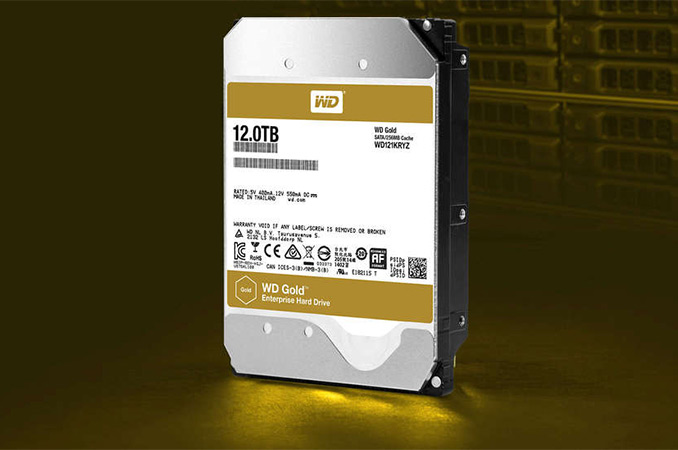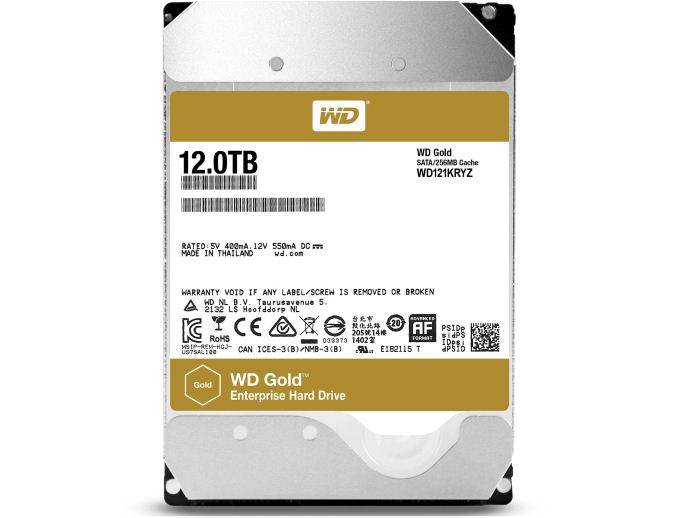Western Digital Ships 12 TB WD Gold HDD: 8 Platters and Helium
by Anton Shilov on September 16, 2017 9:00 AM EST- Posted in
- HDDs
- Storage
- WD
- Western Digital
- Helium HDD
- WD Gold

Western Digital has begun to ship its WD Gold HDD with 12 TB capacity to partners and large retailers. The 3.5” drive relies on the same platform as the HGST Ultrastar He12 launched this year, and will initially be available to select customers of the company. The WD Gold 12 TB is designed for enterprise workloads and has all the performance and reliability enhancements that we come to expect, but the availability at retail should make them accessible to wider audiences.
From a hardware point of view, the WD Gold 12 TB is similar to the HGST Ultrastar He12 12 TB hard drive: both are based on the fourth-generation HelioSeal technology that uses eight perpendicular magnetic recording platters with a 1.5 TB capacity for each platter. The internal architecture of both HDDs was redesigned compared to predecessors to accommodate the eighth platter. Since the WD Gold and the Ultrastar He12 are aimed at nearline enterprise environments, they are equipped with various sensors and technologies to protect themselves against vibration and as a result, guarantee sustained performance. For example, the WD Gold and the Ultrastar He12 attach their spindles both to the top and the bottom of the drives. In addition the HDDs feature a special technology that increases the accuracy of head positioning in high-vibration environments to improve performance, integrity, and reliability. Finally, both product families support TLER (time-limited error recovery) rebuild assist mode to speed up RAID recovery time.
Since the WD Gold 12 TB and the HGST Ultrastar He12 are similar internally and feature the same 7200 RPM spindle speed, they also have similar performance — the manufacturer puts them both at 255 MB/s sustained transfer rate and 4.16 ms average latency. The main difference between the WD Gold and the HGST Ultrastar He12 are the enterprise options for the latter: there are models with the SAS 12 Gb/s interface and there are models with SED support and Instant Secure Erase feature.
| Comparison of Western Digital's WD Gold HDDs | ||||||||
| WD121KRYZ | WD101KRYZ | WD8002FRYZ | WD6002FRYZ | WD4002FRYZ | ||||
| Capacity | 12 TB | 10 TB | 8 TB | 6 TB | 4 TB | |||
| RPM | 7200 RPM | |||||||
| Interface | SATA 6 Gbps | |||||||
| DRAM Cache | 256 MB | 128 MB | ||||||
| NAND Cache | Unknown | No | Yes | Unknown | ||||
| Helium-Filling | Yes | No | ||||||
| Data Transfer Rate (host to/from drive) | 255 MB/s | 249 MB/s | 205 MB/s | 226 MB/s | 201 MB/s | |||
| MTBF | 2.5 million | |||||||
| Rated Annual Workload | 550 TB | |||||||
| Acoustics (Seek) | - | 36 dBA | ||||||
| Power Consumption | Sequential read | 7 W | 7.1 W | 7.2 W | 9.3 W | 9 W | ||
| Sequential write | 6.8 W | 6.7 W | 7 W | 8.9 W | 8.7 W | |||
| Random read/write | 6.9 W | 6.8 W | 7.4 W | 9.1 W | 8.8 W | |||
| Idle | 5 W | 5.1 W | 7.1 W | 7 W | ||||
| Warranty | 5 Years | |||||||
| Price as of September 9, 2017 | MSRP | $521.99 | $410.99 | $327.99 | $244.99 | $183.99 | ||
| Per GB | $0.0435 | $0.0411 | $0.041 | $0.0408 | $0.046 | |||
| GB per $ | 22.98 GB | 24.33 GB | 24.39 GB | 24.48 GB | 21.73 GB | |||
Western Digital aims its WD Gold and HGST Ultrastar He-series drives at operators of cloud and exascale data centers that demand maximum capacity. The 12 TB HDDs can increase the total storage capacity for a single rack from 2440 TB to 2880 TB, replacing 10 TB drives with 12 TB drives, which can be a major benefit for companies that need to maximize their storage capacity per watt and per square meter. Where the HGST-branded drives are made available primarily through B2B channels, the WD Gold are sold both through B2B and B2C channels and thus can be purchased by wider audiences. For example, boutique PC makers, as well as DIY enthusiasts, may start using the WD Gold 12 TB for their high-end builds, something they could not do with the HGST drives. These HDDs may be considered as an overkill for desktops, but since WD’s desktop offerings top at 6 TB, the WD Gold (and the perhaps inevitable future WD Red Pro 12 TB) is the WD’s closest rival for Seagate’s BarraCuda Pro drives.
The WD Gold HDD is currently available directly from Western Digital for $521.99 as well as from multiple retailers, including Newegg for $539.99. While over $500 for a hard drive is expensive, it is actually less than Western Digital charged for its WD Gold 8 TB about 1.5 years ago ($595) and considerably less than the initial price of the WD Gold 10 TB drive last April.
Related Reading:
- Western Digital: Sales of Helium-Filled HDDs Accelerating, 15M Sold So Far
- Western Digital Starts Shipments of HGST Ultrastar He12 12 TB HDDs
- Western Digital Expands Purple Lineup with a 10 TB Helium-Filled HDD
- Western Digital Announces Ultrastar He12 12 TB and 14 TB HDDs
- Western Digital Adds Helium-Filled WD Gold 10 TB HDD to Lineup
Source: Western Digital











62 Comments
View All Comments
Reflex - Sunday, September 17, 2017 - link
https://forums.anandtech.com/search/396521/https://forums.anandtech.com/threads/pm-from-lordr...
Diji1 - Sunday, September 17, 2017 - link
"It only goes to show how clueless you are, assuming such groundless and pathetic intimidation techniques as "people mocking" would work on me."The fact that you write multiple paragraphs in response shows what people mocking you does - it makes you write more idiocy demonstrating your lack of knowledge as you double down on the same thing that got you mocked in the first place.
Samus - Monday, September 18, 2017 - link
I'm personally most comfortable buying spinners at Microcenter or Fry's, ideally in retail packaging, but in the end it doesn't matter. Those drives are shipped securely on a pallet in a 53 foot trailer. The FedEx intern wasn't given the opportunity to whip it up a flight of stairs and jump back in his truck. Beep beep.bill.rookard - Saturday, September 16, 2017 - link
While I certainly appreciate having a high capacity spinny disk, how about putting some R&D into some affordable cost high capacity 3.5" SSD's?Chriz - Saturday, September 16, 2017 - link
I doubt that will happen because they (and other companies) don't care much about SATA SSD's anymore except for the low end. Maybe it could happen if the U2 connector catches on more for NVMe drives.Vatharian - Sunday, September 17, 2017 - link
I hope not! SFF-8643 should stay where it belongs: between HBAs and backplanes, in a rack. Get the hell out of my consumer motherboard! We just barely avoided the disaster of SATA Express. Both have no place here. As a matter of fact the moment SAS 12G has been left without its SATA counterpart, we were left stuck in the past.My reasoning for that is there is absolutely no place for these server-space interfaces to trickle down to John Doe's world, is that we're not going to see any motherboard supporting for example 6 to 8 drives, like it's common with SATA. Beside that, cabling is inconsistent (requiring SFF-8639 for a drives themselves and ugly molex/sata power adapter), and on top of that today chipsets plainly do not have enough bandwidth to handle that kind of transfers.
From my point of view, best course of action would be introducing NVM-e capable standard that would be backwards compatible with existing SATA (with a fallback for older hardware), including single cable for transfers.
Yes, I know, it's not going to happen.
ddriver - Saturday, September 16, 2017 - link
They are affordable. 350$ for 10 TB of storage is pretty good.Put 8 of those in a Z2 pool, and you have yourself over 50 TB of decently reliable storage, fast enough to saturate a 10 gbit link. Total cost of drives plus the nas hardware - less than 4000 $
If you go SSD, for the same price and reliability, you'd max out at about 7 TB for SATA or 4 TB of NVME.
As I've mentioned before, there is quite a lot of headroom to improve mechanical storage performance, however the industry is reluctant to do so. They make more money on flash, especially amidst this artificial shortage, so HDDs will be barely incremental.
extide - Saturday, September 16, 2017 - link
The thing about SSD's is damn near all the BOM cost is the flash itself, so putting more flash into a physically larger drive will just increase the costs a lot, to the point where they would only be suitable for enterprise customers. There is actually a company that makes a 50TB 3.5" SSD -- but don't expect it to be cheap.I knew someone who used to insist that 3.5" SSD's would be cheaper, because making things smaller makes them cost more, right? Well the thing he didn't realise is with a 2.5" SSD, they aren't 'making it smaller' -- that's just the default size. Making them bigger just adds more room for more flash which then costs more.
Cyanara - Saturday, September 16, 2017 - link
Is it safe to say that, being enterprise drives, these would meet and exceed any design attributes recommended for NAS (ie be a fully appropriate alternative to WD Red)?Cyanara - Saturday, September 16, 2017 - link
It's just that these are better value than 10TB WD Red Pro locally even without looking at performance or reliability.